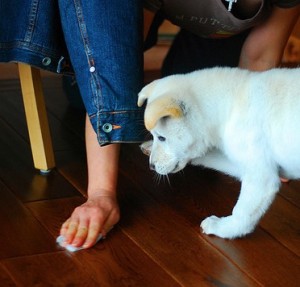Some canine behavior problems, such as house soiling, affect only a dog’s owners. However, problems such as escaping and excessive barking can result in neighborhood disputes and violations of animal control ordinances. Therefore, barking dogs can become “people problems.” If your dog’s barking has created neighborhood tension, it’s a good idea to discuss the problem with your neighbors.
It is perfectly normal and reasonable for dogs to bark from time to time, just as children make noise when they play outside. However, continual barking for long periods of time is a sign that your dog has a problem that needs to be addressed. The first thing you need to do is determine when and for how long your dog barks, and what is causing him to bark.
You may need to do some detective work to obtain this information, especially if the barking occurs when you’re not home. Ask your neighbors, drive or walk around the block and watch and listen for a while, or start a tape recorder or video camera when you leave for work. Hopefully, you will be able to discover which of the common problems discussed below is the cause of your dog’s barking.
Social Isolation/Frustration/Attention Seeking
Your dog may be barking because he’s bored and lonely if:
- He’s left alone for long periods of time without opportunities for interaction with you.
- His environment is relatively barren, without playmates or toys.
- He’s a puppy or adolescent (under 3 years old) and does not have other outlets for his energy.
- He’s a particularly active type of dog (like the herding or sporting breeds) who needs a “job” to be happy.
Recommendations
Expand your dog’s world and increase his “people time” in the following ways:
- Walk your dog daily – it’s good exercise for both of you.
- Teach your dog to fetch a ball or Frisbee and practice with him as often as possible.
- Teach your dog a few commands and/or tricks and practice them every day for five to 10 minutes.
- Take an obedience class with your dog.
- Provide interesting toys to keep your dog busy when you’re not home (Kong -type toys filled with treats or busy-box toys). Rotating the toys makes them seem new and interesting (see our handout, “Dog Toys and How to Use Them”).
- If your dog is barking to get your attention, make sure he has sufficient time with you on a daily basis (petting, grooming, playing, exercising), so he doesn’t have to resort to misbehaving to get your attention.
- Keep your dog inside when you’re unable to supervise him.
- Take your dog to work with you every now and then, if possible.
- If you work very long hours, take him to a doggie day care or have a friend or neighbor walk and/or play with him.
Territorial/Protective Behavior
Your dog may be barking to guard his territory if:
- The barking occurs in the presence of “intruders,” which may include the mail carrier, children walking to school and other dogs or neighbors in adjacent yards.
- Your dog’s posture while he’s barking appears threatening – tail held high and ears up and forward.
- You’ve encouraged your dog to be responsive to people and noises outside.
Recommendations
Teach your dog a “quiet” command. When he begins to bark at a passer-by, allow two or three barks, then say “quiet” and interrupt his barking by shaking a can filled with pennies or squirting water at his mouth with a spray bottle or squirt gun. This will cause him to stop barking momentarily. While he’s quiet, say “good quiet” and pop a tasty treat into his mouth. Remember, the loud noise or squirt isn’t meant to punish him; rather it is to startle him into being quiet so you can quickly reward him. If your dog is frightened by the noise or squirt bottle, find an alternative method of interrupting his barking (throw a toy or ball toward him).
Desensitize your dog to the stimulus that triggers the barking. Teach him that the people he views as intruders are actually friends and that good things happen to him when these people are around. Ask someone to walk by your yard, starting far enough away so that your dog is not barking, then reward him for quiet behavior as he obeys a “sit” or “down” command. Use a very special food reward such as little pieces of cheese or meat.
If you dog’s barking is triggered by sounds like people knocking on the door or a doorbell, you may want to try one of the newer mp3 programmable doorbells, that let you record the sound of your own voice or play another other sound you have saved as an mp3 file. If your dog is barking from boredom, try putting in a DVD created specifically to keep dogs interested. Typically they feature nature sounds, animal noises and even ultrasonic sounds that dogs can hear but we cannot. The DVD we have listed on this page in the lefthand column has come highly recommended.
For the dog who persists in barking, you may want to try either a motion-activated water sprayer (if there is one particular area your dog is fixed on) or a citronella collar, which emits a fine citrus-scented mist just under the dog’s muzzle when it detects a bark. The citronella collars are both humane and effective if you cannot always be around to give your dog an immediate correction.
If you are able to give your dog an immediate correction, I have found a plain old water sprayer works quite well. Just make sure you have it handy in areas where your dog is prone to bark, and set the nozzle for a long distance spray. It’s harmless and gets their attention long enough to distract them from their focus.




